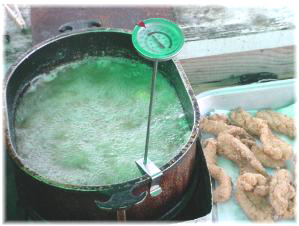Cooking Louisiana - Fried Fish
|
The recipe here can be used for just about any fish and is has a "tight crust" so greasiness is at a minimum. This will fry about 2 lbs of meat dependent upon the number of pieces. Fish preparation Fish come in varying thickness. You may be cooking whole fish or fillets. In either case the thickness of the fish determines how you will prepare it to fry. If piece of fish is about 1/2" to 1" thick it's perfect for frying; any thicker and I slice it in half, or make slits in it. Here's why, first, fish need to be seasoned to taste like anything else. If the piece is too thick you won't get seasoning down to the middle in the case of whole fish. Second, the inside needs to be done and moist while the outside is a little crisp. If the cut is too thick you wind up with a tough outside and not so cooked inside. Of course, be sure the fish is cleaned well and if you're cooking fillets be sure the bones are removed.
Put fish in liquid mix. Mix
it all up and marinade it for 30 or more minutes in the ice box. Don't hesitate to adjust any of this to your liking... Dredge the fish in the dry mix and let sit a minute or so moving it around
just a little. Using a paper bag works good for this too. Just drop the fish in
and shake it up a few times. Use peanut oil, about 2" in the pan depending upon the pan depth. Heat to 350ºF (hot oil will burn you badly, be careful). Place fish in the oil leaving at least a 1/2" to 3/4" space between pieces. Why? If you pack the pan with too much meat the oil cools too much and that equals soggy fish (not good). Timing: Cook the thick (1") pieces for about 4 minutes. The smaller pieces at least 1-2 minutes turning frequently. I watch the bubbling to judge the doneness, I don't time it. If it quits bubbling completely you now have fish leather. With practice you can get each piece done perfectly. You cannot tell how done the fish is by the outer color, it's all in the bubbles! Remove the fish and place on paper towels. Move them around so the grease is soaked up. Taste a piece once they're cooled a little to see if you need to add any seasoning. Transfer them to another pan with more paper towels and cover loosely with paper towels. Let the oil come back to 350ºF for the next batch! Remember, the oil cools as you cook. If you don't have a frying thermometer get one, guessing just don't get it! If the oil gets too hot turn the fire off and let it cool to the right temperature. If the oil smokes you've probably ruined it. A thermometer prevents all of this trouble. Have a little tartar and/or rémoulade sauce, and, lemon handy for extra flavors. Note 1: I am lucky enough to be able to get corn flour (pulverized corn meal) from a wholesale distributor. A 20lb. sack costs about $5.00. You can also use a commercially sold fish fry mix that is made with corn flour (read the ingredients), and comes seasoned and unseasoned. You can also mix corn meal and flour and that works okay too. Some folks use flour alone, it's your preference. Corn meal is coarser than corn flour, hence the name, "corn flour". Corn flour is pulverized corn meal. Note 2: To keep the food warm put the oven on 200°F (or as low as it will go) and let it warm up about 15 minutes. Cover the fish with paper towels (not plastic wrap) or loosely with foil, turn the oven off, and put the pan in the oven. If you seal the pan with plastic wrap or foil the fish will become soggy. If you leave the oven on it will dry out too much. This only works for so long. After a few re-heats the fish will dry out anyway. Note 3: Cooking oil: Different oils have different smoke points. The smoke point is the temperature that the oil begins to smoke and is usually ruined. Peanut oil has the highest rating at 450ºF followed by Canola then Corn (Vegetable) oil. That's why the Peanut oil is preferred for frying. This is just the way I fry fish and I'd like to see the way you do it. Send me your recipe. Enjoy.....
|
|
